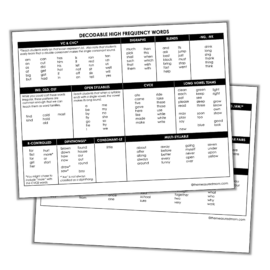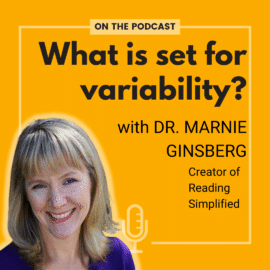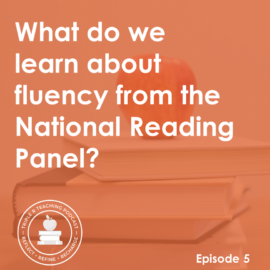
TRT Podcast#54: The most important thing to remember when teaching sight words
There’s a lot of misinformation out there about teaching sight words. In this episode, we boil it down to the MOST important thing to get right.
Listen to the episode here
Full episode transcript
Hello everybody! This is Anna Geiger from The Measured Mom, and we are in the middle of our short series all about sight words here on the Triple R Teaching podcast.
Last week we talked about misconceptions around teaching sight words. This week, in Episode 54, we are going to talk about the most important thing to remember when teaching sight words.
I can say it in just two words. Are you ready?
Phonics first.
There's two implications for that. Number one, we don't teach sight words until students can use phonics to sound out words. And number two, we USE phonics when teaching sight words instead of teaching students to memorize words as wholes. So let me explain both of these implications for phonics first.
Number one, it's really important to remember that young children should not be spending a lot of time learning sight words if they can't sound out words. That isn't to say that there isn't a small set of sight words that we can teach them to memorize, words like "a, I, the, of," and so on - a very small number.
But in general, we should wait to teach sight words until kids can sound out words. In fact, researchers tell us that children will do better at learning sight words, even irregular ones, if they're good at decoding. That's something I learned from Rollanda O'Connor's book, Teaching Word Recognition, which I highly recommend.
There's a lot of confusion around this and a lot of people think that teaching sight words is the way to begin. I totally understand because that's what I used to think! However, children will do better in learning to read if they have a core set of pre-reading skills.
Those important pre-reading skills are concepts of print, where they know how to turn the pages and they know that each word they say is represented on the page. They are language and listening skills, so they can retell a story and they can answer simple questions about it. They include letter knowledge, so they know the letters of the alphabet and most, if not all, of the letter sounds. They include phonological and phonemic awareness, which has to do with things like rhyming, counting syllables, and identifying individual sounds in words. Finally, they include interest in learning to read.
All those things should be present before children learn to read. But that doesn't mean that once those things are present, we start with sight words. We should actually teach them to sound out words.
Like I said, I used to think that students should learn sight words first, and that's because it seems a lot easier. Because I believed this, I used to share a huge set of sight word books for preschoolers and kindergartners to learn to read. I thought they could memorize the repeated sight word and then use the pictures to "read" the rest of the words.
Notice that "read" is in quotes. Although I thought it was "read" for real, because I believed in something called three-queuing, something I learned about in college and grad school. I no longer recommend that. If you want to know more, you can check out my podcast episode, What's Wrong with Three Queuing. I won't get into that today.
What if you understand when I say that you shouldn't start teaching reading with sight words - except for that little handful to get them going - and that you should teach kids to sound out words, BUT your preschooler or kindergartner is really struggling to get those sounds to blend together? Well, then you need to go back to those pre-reading skills and check on them, especially phonemic awareness, and you should start with oral blending.
So if you have the word "cat," you should try to see if they can make the word if they just listen. So if you said, "Put these sounds together to make a word, /c/, /ă/, /t/. What's the word? Cat." If they can't do that oral blending, learning to read is going to be really hard. There's really no point in expecting them to memorize lists and lists of sight words, thinking that's going to help them to learn to read. They have to learn to match those phonemes to the graphemes, those sounds to the letters.
They can't possibly learn to read by memorizing and memorizing and memorizing because their brain can only do that for so long. So rather than thinking that we're teaching them to read by having them memorize these lists of words, because sounding out was hard, we're actually wasting our time! What you're better off doing is spending your time building phonemic awareness, which is a whole different topic, but I have a lot of resources on my website and on this podcast. I will link to them in today's show notes.
Once they understand the concept of decoding words and they're ready to read a simple decodable book, you'll need to teach the high frequency words that are included in the book. Sometimes we call them sight words. Last week, I talked about how that definition of sight words isn't exactly accurate. I know I'm going to confuse you by continuing to use it just because I know that's how many people still use it. But technically, we're talking about high frequency words here, irregular high frequency words.
So if a child is learning to sound out CVC words, the book's text may look like this, "The cat is big." Well, the child can sound out "cat" and "big," but not necessarily "the" and "is," unless you've taught the child that "s" can say /z/. So you'll need to teach those irregular words, but that's not going to be our focus, right? Our focus mostly is going to be on decoding words.
The second thing to remember when it comes to phonics first is to teach sight words or high frequency words, even the irregular ones, within your phonics lessons.
Last week I said that a major misconception about teaching sight words is this idea that we should teach sight words as wholes. That's been around for a long time. In fact, that's what both Edward Dolch and Edward Fry both believed, and they're the ones that came up with the big high frequency word lists that we use today.
If you've ever looked at the Dolch high frequency word list and seen that it's organized by grade level, I'm sure you said, "Hang on a second, who came up with this?" The third grade list has words like "cut, got, hot," and "if," which is frankly pretty ridiculous because if you're in third grade and you can't sound those out, you have a bigger problem than not knowing sight words or high frequency words. So yeah, don't go by that list because it's all about frequency - when those words occur in text for different grade levels - it's not about phonics skill.
It really makes more sense to look at all those common words that are in text and then sort them by phonics skill. So you wouldn't have to teach "cut" by itself, you could just teach it within your phonics lessons when you're teaching kids to sound out CVC words with short u. The same is true for a lot of other words.
Now, does that mean that all of the words are decodable? Definitely not. There are many irregular words on the Dolch and Fry lists, but you can still call attention to the parts that are regular and then have kids memorize the irregular parts. We'll talk more about that next week when I share a simple process for teaching sight words.
Let's quickly review what we went over today.
The most important thing to remember about teaching sight words is phonics first. Phonics first means two things. We do not start beginning readers with sight words. Sure, we can teach them a small handful of sight words just to get them going, but that is not the main focus. We want to build those pre-reading skills, phonemic awareness, and the skill of phonic decoding BEFORE we teach a lot of high frequency words. Researchers tell us the better kids are at decoding words, the better they're going to be at reading those irregular high frequency words as well. So decoding is really important!
The number two thing to remember about phonics first is that we should be teaching these high frequency words, both regular and irregular, within the context of phonics lessons. Many, many of the words, probably at least half that we find on these high frequency word lists, are actually fully decodable. Teach them within your phonics lessons. For the others, we can call attention to the decodable parts and special attention to the parts that are irregular, which we'll get into more next time.
Please remember I've got a full blog series on my website right now all about sight words. You can go to themeasuredmom.com/sightwordseries.
I have a really special gift for you that's available now, I put together a list of sight words or high frequency words organized by phonics skill. It's on my website and you can find it by going to themeasuredmom.com/phonicsandsightwords. So it's themeasuredmom.com/phonicsandsightwords. That has both the regular and irregular words organized by phonics skill.
Check that out and print it for yourself as a ready reference, and stay tuned because next week we have a very special offer for Black Friday and Cyber Monday and it's all about a complete new resource we have for teaching high frequency words to master.
You can find the show notes for this episode at themeasuredmom.com/episode54. See you next week!
Sign up to receive email updates
Enter your name and email address below and I'll send you periodic updates about the podcast.
Related blog posts, podcast episodes, and other resources
- Our sight word blog series begins here.
- Strongly recommended book (I read the whole thing cover to cover – a rarity for me!): Teaching Word Recognition, by Rollanda E. O’Connor
- 5 important pre-reading skills
- Do’s and don’ts for teaching phonemic awareness
- What’s wrong with three-cueing?








Leave a Comment